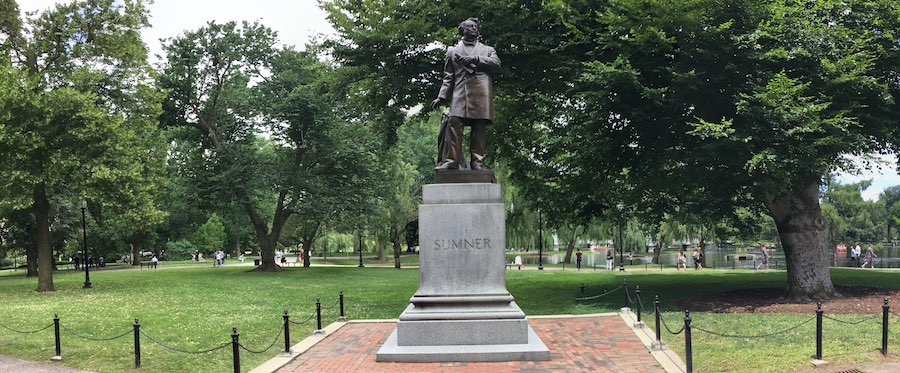Senator Charles Sumner Statue
In the Boston Public Gardens, along Boylston Street, are four bronze statues on granite pedestals that have stood as a group for more than eighty years.
The first statue to be placed on this path is simply labeled, 'Sumner.' This is a statue of Massachusetts Senator Charles Sumner.
Today's post is about Senator Charles Sumner.

Five things that I learned about the Charles Sumner Statue
- Statue was unveiled on December 23, 1878 (4 years, 9 months, 13 days after Charles Sumner died)
- The face of the statue is faccing towards the Four Season Hotel on Boylston Street.
- There is a small inscription "Tomas Bell Sc. 1877" near the right foot. (This is a typical artist signature)
- There are No quotes or Inscriptions on the granite other than the last name on the Statue.
- Charles Sumner is holding a scroll - which I assume characterize his devotion to his work in the Senate.
- There are three lights around the statue, two in the front and one in the back. So the status will be visible at night.
Ten General Information Facts about Charles Sumner
- Born in Boston on January 6, 1811 and lived on Irving Street on Beacon Hill
- Attended Boston Latin School and graduated Harvard in 1830
- Republican Senator from Massachusetts from April 24, 1851 to March 11, 1874
- Had strong anti-slavery views.
- On May 22, 1856, He was attacked with a cane in the Senate by Preston Brooks after Charles Sumner suggested that Kansas should enter the Union as a free state.
- Introduced the the 13th Amendment to the Senate in 1864
- Fought hard for the Impeachment of Andrew Johnson, when the Senate Acquitted Johnson, Charles Sumner wanted to try again.
- Died in Washington DC on March 11, 1874 (Age 63)
- Buried at Mount Ardburn Cemetery
- Papers of Charles Sumner can be found in Microfilm in the Boston Public Library in Copley Square
Controversy over the Charles Sumner Statue
In 1876, the Boston Art Committee put out a formal notice that they were looking for a statue design for Charles Sumner to be placed in the Boston Public Gardens. They held a contest at the Old State House with several prominent designers showcasing their statue idea.
After much consideration, the committee picked the design done by Anne Whitney in a blind competition. However, when she went to collect her reward they rejected the design since the sculptor was a woman. The committee didn't like the idea of women designing a man's leg.
The committee then selected Thomas Ball designed instead. (Anne Whitney still kept the prize money.)
In 1902, the version of the statue Anne Whitney's created was placed in a small park across from Harvard University in Harvard Square in Cambridge, Massachusetts.
Anne Whitney got the last laugh as her version of Charles Sumner statue is seen far more than Thomas Ball version.
Fighting for Civil Rights
Charles Sumner fought hard for Civil Rights. One of the last bills he introduced to the Senate was a civil rights bill to guarantee to all citizens, regardless of color, "equal and impartial enjoyment of any accommodation, advantage, facility, or privilege." On his death bed he asked Frederick Douglas - "Don't let the bill fail!" and "You must take care of [my] civil-rights bill."
The Civil Right Act of 1865 passed on March 1, 1865, almost a year to the day that Charles Sumner died. The act was also known as the Butler-Sumner Act.
However, seven years later the Supreme Court threw out the Civil Rights Act of 1875 in four rulings: United States v. Stanley; United States v. Ryan; United States v. Nichols; United States v. Singleton; Robinson et ux. v. Memphis & Charleston R.R. Co.
It would be another 80 years before Congress could pass a civil rights act.
East Boston Sumner Tunnel
The tunnel between East Boston and Boston is called the Sumner Tunnel. However, it's named after William H. Sumner and not Charles Sumner.
William H. Sumner was responsible for building up East Boston, that's why the Tunnel is named after him. Charles Sumner had nothing to do with East Boston.
Both men did live around the same time, but they are not related.
Locating The Statue
The statue is located in the Boston Public Gardens along Boylston Street.
At the corner of Arlington and Boylston take the right most path in the Public Gardens. It will be the first statue on your left.
Tip: You can get some nice pictures of the Swan Boats from this location.
